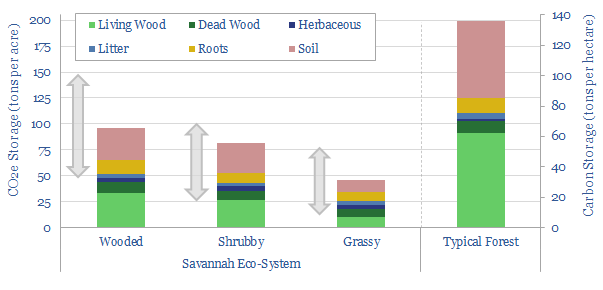Savanna carbon is stored in an open mix of trees, brush and grasses. Savannas comprise up to 20% of the world’s land, 30% of its annual CO2 fixation, and we estimate their active management could abate 1GTpa of CO2 at low cost. This 17-page research note was inspired by exploring some wild savannas and thus draws on photos, observation, anecdotes, technical papers.
Savannas landscapes are summarized on pages 2-4, following some on-the-ground exploration of these landscapes near Kruger National Park in 2022, which made us take a deeper interest in savanna carbon.
As a result, we are re-thinking three conclusions about nature and climate, as part of our roadmap to net zero:
(1) Conservation is as important as reforestation and should not be dismissed. Once slow-growing trees and endangered species are lost, they are not coming back (pages 5-7).
(2) Optimization of CO2 is particularly nuanced in savanna landscapes and must be balanced with other environment goals, especially biodiversity (pages 8-11). This is especially true for fire suppression (pages 12-14). Learning curves are crucial (pages 11, 15).
(3) Re-wilding pasturelands into savannas may absorb 50–100 tons of CO2 per acre. This is less than forests. But it may be more achievable in certain climates. And where it attracts tourist revenues, CO2 abatement costs may actually be sub-zero (pages 14-16).
Our conclusions and CO2 quantifications of savanna carbon are summarized on page 17.
Underlying data into the CO2 absorption of tree species and savanna landscapes is tabulated here. As an approximate breakdown, 33% of the CO2 is stored in soils, 33% in living woody tissue, and the remainder is distributed across roots, dead wood, shrubs and litter.

